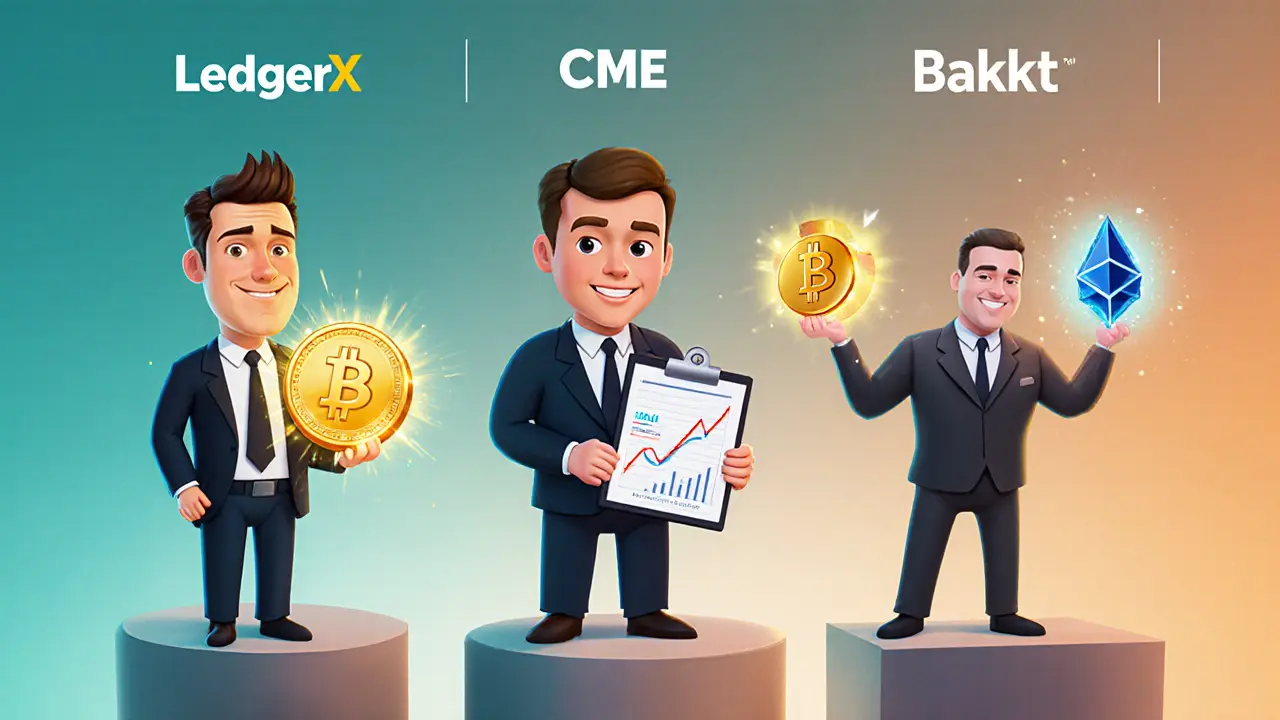LedgerX Product Comparison Tool
LedgerX
Fully regulated by CFTC with physical Bitcoin settlement
- Bitcoin-only options & futures
- Physical settlement
- Mini contracts (0.01 BTC)
- Algorithmic trading support
CME Bitcoin Futures
Established exchange with cash-settled Bitcoin futures
- Bitcoin futures only
- Cash settlement
- No options
- Lower minimum contract size (1 BTC)
Key Comparison Features
| Feature | LedgerX | CME | Bakkt |
|---|---|---|---|
| Regulatory Body | CFTC (full exchange license) | CFTC (exchange-listed futures) | CFTC (regulated futures & spot) |
| Settlement Type | Physical Bitcoin delivery | Cash-settled | Physical for spot, cash for futures |
| Supported Assets | Bitcoin only | Bitcoin futures only | Bitcoin & Ethereum |
| Minimum Contract Size | 0.01 BTC (mini contracts) | 1 BTC | 0.001 BTC (spot), 0.01 BTC (futures) |
| Algorithmic Trading | Yes, via API & block desk | Limited API, no block desk | API available, block desk limited |
| Typical Maker Fee | 0.02% (tiered) | 0.02% (tiered) | 0.015% (tiered) |
Why Choose LedgerX?
- Full CFTC regulation ensures compliance and legal protection
- Physical Bitcoin delivery provides real asset exposure
- Mini contracts allow entry with smaller capital
- Advanced API for algorithmic trading strategies
- Dedicated block-trade desk for institutional clients
Important Note
While LedgerX offers unique advantages with physical settlement and regulatory compliance, it's important to consider that:
- It's Bitcoin-only (no Ethereum or other cryptocurrencies)
- Higher capital requirements due to physical delivery
- Fee structure may be less competitive for low-volume traders
Compare these factors with your trading goals and risk tolerance before making decisions.
When you hear LedgerX described as a regulated Bitcoin spot and derivatives exchange operating under the U.S. Commodity Futures Trading Commission (CFTC), the first thing that comes to mind is institutional‑grade compliance paired with real Bitcoin delivery.
Quick Take
- Fully regulated by the CFTC U.S. regulator overseeing futures and derivatives markets.
- Offers Bitcoin options contracts that give the right, but not the obligation, to buy or sell Bitcoin at a preset price and futures with physical settlement.
- Physical settlement means you receive actual Bitcoin, not cash.
- Supports algorithmic and block trading for institutions.
- Fee schedule is tiered; maker fees can be as low as 0.02%.
What Makes LedgerX Different?
Most crypto exchanges operate in a regulatory gray zone, but LedgerX sits under the federal oversight of the CFTC. That oversight forces the platform to meet strict capital, reporting, and anti‑money‑laundering (AML) standards. For retail traders, the upside is peace of mind: your positions are recorded on a compliant ledger and can be audited if needed.
The exchange’s focus on **physical settlement** is a rarity. While competitors like CME Group’s Bitcoin futures settle in cash, LedgerX delivers the underlying Bitcoin at contract expiry. This matters if you want genuine exposure to the asset rather than a synthetic price track.
Trading Products on LedgerX
LedgerX’s product suite revolves around Bitcoin:
- Bitcoin options European‑style contracts with strike prices historically ranging from $2,000 to $50,000. Expiries run weekly, monthly, and quarterly.
- Bitcoin futures Standardized contracts that settle in actual Bitcoin at expiry.
- “Mini” contracts introduced in 2022, allowing 0.01BTC exposure per contract - a good entry point for smaller accounts.
The platform also offers a sandbox API for algorithmic strategies and a dedicated block‑trade desk for large institutions looking to move volumes discreetly.
Fees, Costs, and Margin Requirements
LedgerX follows a maker‑taker model:
- Maker (providing liquidity) fees start at 0.02% and can drop to 0.00% for high‑volume traders.
- Taker (removing liquidity) fees range from 0.07% to 0.12% depending on monthly turnover.
- There is a nominal settlement fee of 0.001BTC per physical delivery.
- Margin is set at 20% of contract notional for standard futures; mini contracts require 10%.
Unlike cash‑settled platforms, the need to hold actual Bitcoin for settlement can increase capital outlay, especially during high‑volatility periods.
Platform Features and Usability
The web interface mirrors traditional futures desks: depth charts, order‑book heatmaps, and real‑time Greeks for options. For developers, the REST and WebSocket APIs cover order placement, market data, and account management. The API documentation is versioned and includes sample code in Python, Java, and C#.
Algorithmic traders appreciate the low‑latency feed (sub‑50ms) and the ability to submit bulk orders via the block‑trade desk. Retail users benefit from a three‑step onboarding process: submit KYC/AML forms, fund the account with either USD (via ACH) or Bitcoin, and start trading. Verification usually completes within 24hours for U.S. residents.

Pros and Cons at a Glance
- Pros
- Full CFTC regulation - strong legal protection.
- Physical Bitcoin settlement provides real exposure.
- Algorithmic and block‑trade capabilities.
- Mini contracts lower the entry barrier.
- Cons
- Limited to Bitcoin; no multi‑crypto offerings.
- Higher capital requirements due to physical settlement.
- Fee structure can be less competitive for low‑volume traders.
- Public information on latest product updates is sparse.
How to Get Started
- Visit the LedgerX sign‑up page and create an account.
- Complete the KYC questionnaire - you’ll need a government ID, proof of address, and a brief source‑of‑funds statement.
- Fund the account. You can transfer USD via ACH (2‑3 business days) or send Bitcoin to the generated deposit address.
- Navigate to the “Trade” tab, choose either “Options” or “Futures”, set your strike price (for options) or contract size, and place a limit or market order.
- Monitor positions through the “Portfolio” view. If you hold a physical‑settlement contract to expiry, LedgerX will automatically credit your Bitcoin wallet.
LedgerX vs. Competitors
| Feature | LedgerX | CME Bitcoin Futures | Bakkt |
|---|---|---|---|
| Regulatory body | CFTC (full exchange license) | CFTC (exchange‑listed futures) | CFTC (regulated futures & spot) |
| Settlement type | Physical Bitcoin delivery | Cash‑settled | Physical for spot, cash for futures |
| Supported assets | Bitcoin only (options & futures) | Bitcoin futures only | Bitcoin & Ethereum (spot & futures) |
| Minimum contract size | 0.01BTC (mini contracts) | 1BTC | 0.001BTC (spot), 0.01BTC (futures) |
| Algorithmic trading | Yes, via API & block desk | Limited API, no block desk | API available, block desk limited |
| Typical maker fee | 0.02% (tiered) | 0.02% (tiered) | 0.015% (tiered) |
If you value actual Bitcoin ownership at contract expiry, LedgerX stands out. For pure cash exposure or broader asset choice, CME and Bakkt may feel more flexible.
Regulatory Outlook and Future Outlook
Since its launch, LedgerX has processed over 10million contracts, proving that a regulated Bitcoin derivatives venue can attract serious market participants. The U.S. regulatory environment is tightening, with the SEC and CFTC collaborating on clearer guidance for crypto derivatives. That climate could favor LedgerX, as its existing CFTC license positions it ahead of newcomers who must still secure approvals.
However, competition is fierce. Larger exchanges are adding Bitcoin options and physical‑settlement products, eroding LedgerX’s uniqueness. The platform’s Bitcoin‑only focus may also limit growth as investor interest spreads to Ethereum, Solana, and other tokens. Watching LedgerX’s product roadmap for multi‑asset expansion will be key for future relevance.
Final Verdict
LedgerX offers a rare blend of regulatory certainty and true Bitcoin exposure. It’s a solid fit for institutional traders, algorithmic strategists, and experienced retail investors who need compliance and don’t mind the higher capital lock‑up. If you’re a casual trader looking for low‑fee, multi‑crypto futures, you might gravitate toward larger venues. In short, LedgerX is the go‑to platform when compliance and physical settlement matter most.
Frequently Asked Questions
Is LedgerX safe for retail investors?
Yes. Because LedgerX is licensed by the CFTC, it must meet strict capital, reporting, and AML requirements, providing a higher safety net than many offshore platforms.
Can I trade Ethereum on LedgerX?
No. LedgerX currently only offers Bitcoin‑based options and futures. If you need Ethereum exposure you’ll have to look at other regulated venues like Bakkt or CME.
What is the difference between cash‑settled and physically‑settled contracts?
Cash‑settled contracts pay out the profit in USD based on the price difference at expiry. Physically‑settled contracts deliver the underlying asset-in LedgerX’s case, actual Bitcoin-directly to your wallet.
How do I fund my LedgerX account?
You can fund via ACH (USD) or by sending Bitcoin to the deposit address generated in your account dashboard. ACH takes 2‑3 business days; Bitcoin transfers are instant after network confirmations.
Does LedgerX charge a fee for withdrawing Bitcoin?
Yes. There is a flat settlement fee of 0.001BTC for each physical‑settlement contract that matures. Regular withdrawals from the wallet incur a network fee only.


Elizabeth Mitchell
LedgerX is the only place I trust for actual Bitcoin delivery. Cash-settled futures feel like gambling with IOUs. If you’re serious about owning the asset, this is the only game in town.